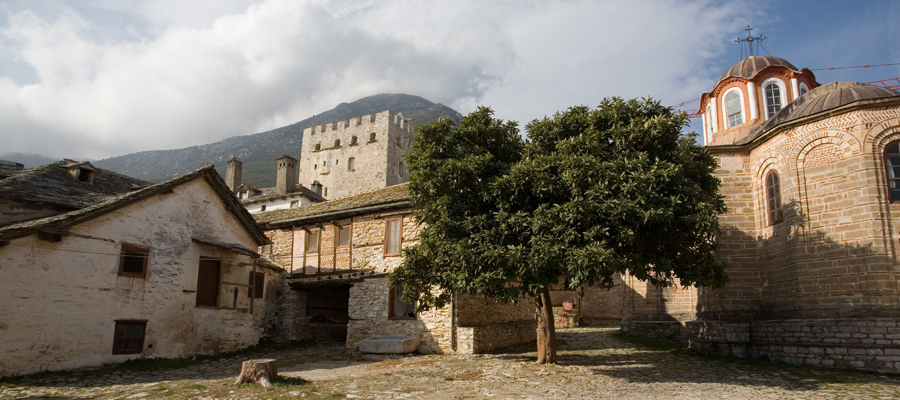Megistis Lavras monastery
It is also named Lavra of Athanasios. It is located in Akrathos cape, in the southeastern side of the peninsula and is seven hours of walk from Karyes. It is the oldest in Athos and is rightfully the first in hierarchy among the other twenty. Its founder was Athanasios the Athonite, who built it in 963 with encouragement and assistance of Emperor Nikephoros Phokas, who intented of retiring in Athos. He is considered one of the greatest figures of orthodox cenobitic monasticism. According to tradition, the copper gates of the churche’s narthex come from the spoils the Emperor taken from the Saracens during the reoccupation of Crete.
Lavra received privileges by Nikephoros Phokas, that declared it an imperial monastery, independent from the local church authorities and granted it an annual income of 244 gold coins.
700 monks lived in the fortress-like, monastic complex in the 11th century. The fact that 50 Saints emerged and 27 Patriarchs and 145 Bishops served the church from its fraternity certifies its prosperity.
Athanasios supervised the construction of the 600sq.m. Catholicon, the cells, the hospital, the kitchen and the aqueduct. The temple was originally dedicated to the Annunciation but since the 15th century is celebrated on the day of the assumption of Saint Athanasios. Its architectural type is composite, four-pillar, cruciform with a dome, that was commonly named “Agioritikos rhythm” and is found in most Athonite monasteries. The frescoes made in 1535, is a work of famous Theofanis of Crete, whereas Giannoulis Chalepas made the marble “iconostasio” (icon‐screen) in 1870. The yard with the huge cypress trees and the fountain, has 37 chapels one of which is Panagia Koukouzalissa, with the wonderful portable picture of the palaiologean era.
The monastery had been favored by the powerful of each era during its thousand year old history. Constantine VIII, after monks’ request, sent highly ranked officials of the Palace to prevent the taxation from local lords. In 1259, Michael XIII, confirmed its wealth with a Golden Bull and granted the village Toxobus. Andronicus II followed the same policy. Great Abbots such as Filotheos Kokkinos and Gregory Palamas came from the monastery. Its historic course continued with the raids of the Catalan Company and with the occupation of Mount Athos from the Serbs and the short occupation of the Ottomans in 1387.
Many holy relics are kept here, and inside its sacristy are the imperial purple mantle, the crown and the gospel of Nikephoros Phokas, manuscript gospels, gifts from Russian Tsars, chinese porcelain, italian plates and weapons, among others. The collection of portable pictures is more than 2.000 in size. Its library with the 2.800 codes, hundreds of rare manuscripts, 8.000 documents and 11.000 books, is ranked among the most important and richest in the orthodox world, since 1500.
Text: Dr. Antonios G. Dikaios/ Theologian – Environmentalist.






